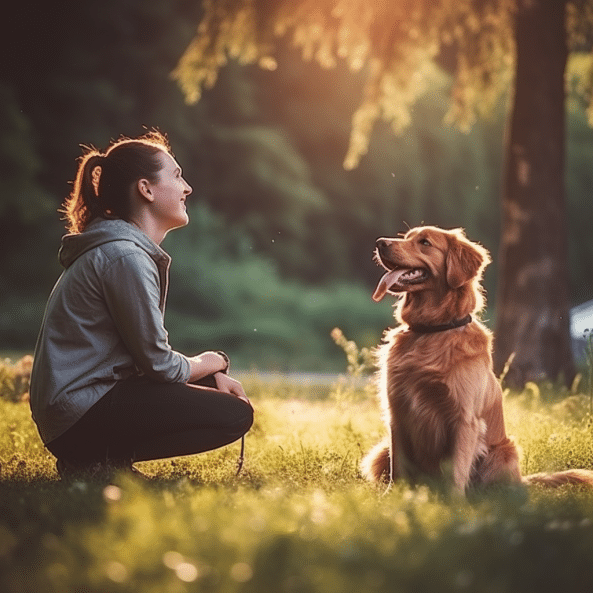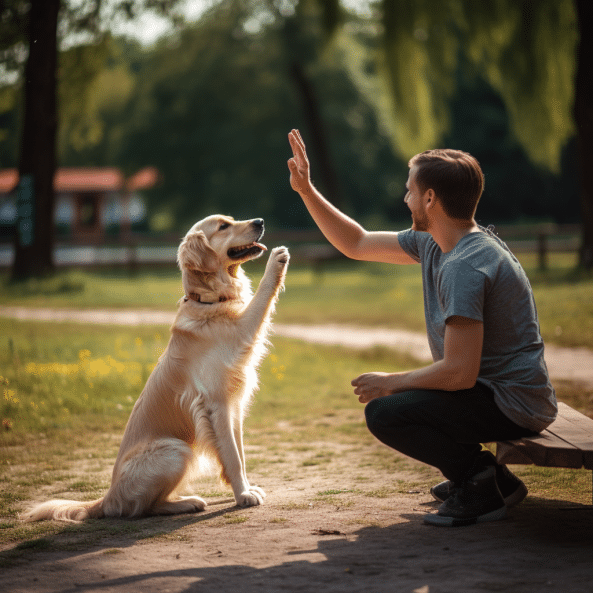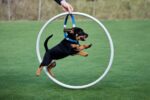Transformative Dog Training

Positive reinforcement is a highly effective technique in dog training that focuses on rewarding desired behaviors rather than punishing unwanted behaviors. By utilizing positive reinforcement, dog owners can create a positive learning environment that promotes better behavior, bonding, and understanding between dogs and their owners. This reward-based training approach emphasizes motivation and encourages dogs to engage and learn willingly. Let’s explore the benefits and significance of positive reinforcement in dog training.
The Controversy Surrounding Aversive Training Methods

Aversive training methods, such as the use of prong collars, have sparked a heated controversy in the world of dog training. These methods involve the application of physical punishment to discourage unwanted behaviors in dogs. However, animal welfare organizations and experts argue that these techniques are not only cruel but also ineffective and potentially harmful to both animals and humans.
“Aversive training methods are outdated and based on the concept of dominance and control,” says renowned dog trainer and behaviorist, Dog Daddy.
“Using harsh tools like prong collars can cause physical and psychological harm to dogs, leading to fear, anxiety, and aggression. It goes against the principles of positive reinforcement, which focuses on rewarding desired behaviors and building a trusting relationship between dogs and their owners.”
The controversy surrounding aversive training methods has highlighted the need for a more compassionate and scientifically sound approach to dog training. Training methods that prioritize the use of positive reinforcement, rewards, and motivation have been proven to be more effective in promoting learning, facilitating behavior modification, and strengthening the bond between dogs and their owners. By shifting the focus from punishment to positive experiences, dog training can become a more humane and successful endeavor.
| Table: Comparison of Aversive Training vs. Positive Reinforcement Training | |
|---|---|
| Aversive Training | Positive Reinforcement Training |
| Relies on physical punishment | Focuses on rewarding desired behaviors |
| Can cause fear, anxiety, and aggression | Promotes trust, confidence, and understanding |
| May lead to negative behavior outcomes | Facilitates behavior modification and learning |
| Based on dominance and control | Builds a positive relationship between dogs and owners |
The controversy surrounding aversive training methods serves as a reminder of the importance of embracing positive reinforcement techniques in dog training. By using rewards, motivation, and gentle guidance, dog owners and trainers can create a positive learning environment that nurtures the well-being and happiness of dogs while achieving desired behavior outcomes.
Positive Reinforcement in Ratting Training
Positive reinforcement is a highly effective and enjoyable approach in ratting training. This type of training not only taps into a dog’s natural abilities but also strengthens the bond between dogs and their owners. By utilizing positive reinforcement techniques, ratting training becomes a positive and safe experience for all parties involved.
In ratting training, dogs are rewarded for sniffing out vermin, promoting their natural instincts and providing mental stimulation. This reinforcement helps dogs understand which behaviors are desired and encourages them to continue performing these actions. By associating the reward with the behavior, dogs develop a positive association with ratting, leading to a more enjoyable and successful training experience.
Safety is a top priority in ratting training. Measures are in place to ensure the safety and well-being of the rats, as well as the dogs. Positive reinforcement techniques create an environment where dogs are motivated to sniff out vermin without causing harm. This approach fosters a sense of trust and cooperation between the dogs and their owners, further strengthening their bond.
Table: Benefits of Positive Reinforcement in Ratting Training
| Benefits | Description |
|---|---|
| Bonding | Positive reinforcement enhances the bond between dogs and their owners during ratting training. |
| Mental Stimulation | Ratting training provides dogs with mental stimulation, satisfying their natural instincts. |
| Safety | Positive reinforcement techniques prioritize the safety of both dogs and rats involved in training sessions. |
| Enjoyable Experience | Positive reinforcement creates a positive and enjoyable environment for dogs to utilize their natural abilities. |
Ratting training with positive reinforcement is a rewarding and beneficial experience for dogs and their owners. It allows dogs to engage in their natural instincts while strengthening their bond with their owners. By prioritizing safety and utilizing positive reinforcement techniques, ratting training becomes a positive and enjoyable activity for dogs of all breeds.
The Benefits of Positive Reinforcement in Puppy Training
Puppy training is a crucial phase in shaping a well-behaved adult dog. Employing positive reinforcement techniques in this process yields numerous benefits for both the owner and the pup. Emphasizing rewards for desired behaviors creates a positive learning environment and builds trust between the owner and the puppy. Positive reinforcement not only cultivates happy experiences by associating good behaviors with pleasant outcomes but also plays a vital role in socializing the puppy. Introducing them to new experiences in a positive and rewarding manner helps form positive associations and reduces fear or anxiety. It is essential to avoid punitive measures and focus on positive reinforcement, using treats, praise, or play to teach new skills, ensuring a lifetime of effective training and a content, well-adjusted canine companion.
Table: The Benefits of Positive Reinforcement in Puppy Training
| Benefits | Explanation |
|---|---|
| Positive experiences | Creating enjoyable learning opportunities for puppies through rewards and praise. |
| Building confidence | Helping puppies develop self-assurance by reinforcing their desired behaviors. |
| Socializing effectively | Teaching puppies to have positive associations with new animals, people, and stimuli, promoting friendly and confident behavior. |
By incorporating positive reinforcement techniques into your puppy training, you can create a safe and supportive learning environment while also strengthening the bond between you and your pup. Remember to be patient, consistent, and always use rewards that are motivating for your puppy. With time and dedication, positive reinforcement will help shape your puppy into a well-mannered and happy adult dog.
Teaching Actionable Skills Instead of Disciplining
When it comes to dog training, teaching actionable skills is a more effective approach than disciplining unwanted behaviors. Instead of focusing on punishment, positive reinforcement techniques emphasize rewarding desired behaviors and creating a positive learning history. By doing so, dogs can learn new skills, build confidence, and develop a trusting bond with their owners.
“Teaching actionable skills through positive reinforcement allows dogs to associate learning with positive experiences,” says Dr. Emily Johnson, a renowned canine behavior expert. “This approach helps dogs understand what is expected of them and motivates them to engage in desired behaviors.”
Through positive reinforcement, dogs can be taught important skills such as “leave it” or “drop it” without the need for punishment. By rewarding and reinforcing these behaviors with treats, praise, or play, dogs learn to make positive associations and are more likely to engage in these actions willingly.
“I have witnessed the transformation in my own dog,” says Sarah Collins, a dog owner who recently switched to positive reinforcement training. “Instead of fearing reprimands, my dog now eagerly listens and responds to commands, knowing that good behavior is always met with rewards. It has completely changed the dynamics of our relationship.”
Benefits of Teaching Actionable Skills Using Positive Reinforcement:
- Encourages desired behaviors: Positive reinforcement focuses on rewarding wanted behaviors, making dogs more likely to repeat them.
- Builds trust and confidence: Dogs develop a positive learning history and see their owners as a source of support and guidance.
- Promotes a positive and enjoyable learning environment: Dogs associate training with positive experiences, leading to higher engagement, faster learning, and better retention of new skills.
- Strengthens the bond between dogs and their owners: Positive reinforcement training builds a trusting and collaborative relationship based on mutual understanding and respect.
| Actionable Skills | Positive Reinforcement Techniques |
|---|---|
| “Leave it” | Rewarding the dog for turning their attention away from the object of interest |
| “Drop it” | Praising and giving treats when the dog voluntarily releases an item |
| “Stay” | Gradually increasing the duration and rewarding the dog for remaining in position |
| “Recall” | Using high-value treats or favorite toys to reward the dog for coming when called |
By prioritizing positive reinforcement and teaching actionable skills, dog owners can create a harmonious and fulfilling training experience for both themselves and their furry companions. Through patience, consistency, and the use of rewards, dogs can develop a repertoire of desired behaviors while strengthening their bond with their owners.
Training Tools for Positive Reinforcement
When it comes to implementing positive reinforcement in dog training, having the right tools can make all the difference. Here are some essential training tools that can help you create a successful training plan:
Clicker
A clicker is a small handheld device that makes a distinct clicking sound. It is used to mark desired behaviors in dogs and serves as a signal that a reward is coming. The clicker helps to precisely communicate to your dog which behavior is being reinforced, making it an effective tool for shaping their behavior.
Treat Pouch
A treat pouch is a handy accessory that allows you to keep training treats readily accessible during training sessions. It attaches securely to your waist or belt and keeps your hands free, making it easier to focus on training and reward your dog promptly. A treat pouch is a practical and convenient tool for positive reinforcement training.
Training Treats
High-quality training treats are essential for rewarding good behavior and motivating your dog during training. Look for treats that are tasty and appealing to your dog, as they will be more effective as a reward. Bocce’s Bakery treats and Stewart freeze-dried beef liver are popular options that many dogs find irresistible.
Training Books
It can be useful tools for learning more about positive reinforcement strategies and how to effectively implement them in your training sessions. “Training the Best Dog Ever: A 5-Week Program Using the Power of Positive Reinforcement” is a highly recommended book that provides a full approach on positive reinforcement training.
| Training Tool | Description |
|---|---|
| Clicker | A handheld device that makes a distinct clicking sound to mark desired behaviors. |
| Treat Pouch | Attaches to your waist or belt, keeping training treats easily accessible during sessions. |
| Training Treats | High-quality treats that are appealing to your dog and serve as a motivating reward. |
| Training Books | Valuable resources that provide guidance and in-depth knowledge about positive reinforcement training. |
Happy Ratters: A Positive Reinforcement Ratting Class
Happy Ratters is a unique ratting class that offers a positive and rewarding experience for both dogs and their owners. This class focuses on creating positive experiences, emphasizing safety, and strengthening the bond between dogs and their owners. Whether your dog is a terrier, a spaniel, or a mixed breed, they are welcome to join this inclusive and enjoyable class.
In Happy Ratters, positive reinforcement techniques are used to teach dogs how to sniff out vermin, all while ensuring the safety and well-being of all participants, including the rats. By rewarding dogs for their natural abilities and instincts, this class provides both mental and physical stimulation that is essential for a happy and well-rounded dog.
H3: Ratting Fun for All Breeds
One of the unique aspects of Happy Ratters is that it is open to dogs of all breeds, ages, and abilities. This means that whether you have a small Chihuahua or a large Golden Retriever, they can participate in this fun and engaging class. The variety of breeds adds to the excitement and creates a diverse learning environment for everyone involved.
| Breed | Size | Ability |
|---|---|---|
| Chihuahua | Small | Competent |
| Golden Retriever | Large | Highly skilled |
| Terrier | Medium | Excellent |
| Spaniel | Medium to Large | Adequate |
In Happy Ratters, dogs are encouraged to use their natural abilities and instincts, regardless of their breed or size. This creates a positive and inclusive learning environment where every dog can thrive and enjoy the ratting experience.
Join Happy Ratters and experience the joy of ratting with positive reinforcement techniques. With a focus on positive experiences, safety, and a variety of breeds, this class offers a rewarding and fun-filled experience for both dogs and their owners.
The Importance of Tailoring Training Plans
When it comes to dog training, one size does not fit all. Each dog has its own unique pace, learning style, and needs. That’s why it is crucial to tailor training plans to suit the individual dog. By personalizing the training approach, we can ensure that the dog learns effectively and feels supported throughout the process.
One of the key aspects of tailoring a training plan is selecting the right training tools. Different dogs respond differently to various tools, so it’s essential to choose tools that resonate with the dog and the owner. Whether it’s a clicker, treat pouch, or specific training treats, the right tools can make a significant difference in the training outcome.
The Importance of Individual Pace
Every dog learns at its own pace. Some dogs may pick up new skills quickly, while others may need more time and repetition. It’s important to be patient and allow the dog to progress at its own pace. Rushing the training process can lead to frustration and setbacks. By acknowledging and respecting the dog’s individual pace, we can create a positive and successful training experience.
Choosing the Right Training Tools
The selection of training tools is another critical aspect of tailoring training plans. It’s essential to choose tools that align with the dog’s preferences, sensitivities, and learning style. For example, some dogs may respond well to a clicker, while others may prefer verbal cues or hand signals. By selecting the right tools, we can enhance the training experience and increase the dog’s motivation to learn.
| Training Tool | Usage | Advantages |
|---|---|---|
| Clicker | Marking desired behavior | Clear and consistent communication |
| Treat pouch | Convenient access to rewards | Hands-free training |
| Training treats | Rewarding good behavior | Motivating and tasty |
In conclusion, tailoring training plans to suit each dog’s individual pace and needs is crucial for successful and effective training. By selecting the right training tools and allowing the dog to learn at its own speed, we can create a positive and supportive learning environment. Remember, every dog is unique, and their training should reflect that uniqueness.
Creating a Safe and Enriching Environment
When implementing positive reinforcement training, it is crucial to create a safe and enriching environment for your dog. This involves implementing effective safe management systems to prevent unwanted behaviors and provide ample opportunities for positive stimulation. By prioritizing safety and enrichment, you not only enhance your dog’s learning experience but also promote their overall well-being.
One way to ensure a safe environment is by setting clear boundaries and using appropriate management tools. This may include using baby gates or crates to restrict access to certain areas, especially during training sessions or when you’re unable to supervise your dog. It’s important to avoid leaving your dog unattended in potentially unsafe situations, such as with access to hazardous substances or objects.
Additionally, providing enriching experiences and positive stimulation is essential for your dog’s mental and physical well-being. This can be achieved through interactive toys, puzzle feeders, and regular exercise. Consider incorporating a variety of activities that cater to your dog’s specific needs and interests, such as scent work, agility, or obedience training. This not only keeps your dog mentally engaged but also helps prevent boredom and unwanted behaviors.
“Creating a safe and enriching environment is crucial for positive reinforcement training.”
Table: Safe Management and Enriching Environment Tips
| Safety | Enrichment |
|---|---|
| Use baby gates or crates to restrict access to unsafe areas. | Provide interactive toys and puzzle feeders for mental stimulation. |
| Avoid leaving your dog unattended in potentially hazardous situations. | Incorporate regular exercise and physical activities. |
| Keep hazardous substances and objects out of reach. | Consider engaging in specific activities that cater to your dog’s interests. |
By creating a safe and enriching environment, you not only create a positive learning environment for your dog but also help build a strong bond based on trust and positive reinforcement. Remember, dogs thrive in an environment where they feel secure and stimulated, and by prioritizing their safety and enrichment, you set them up for success in their training journey.
Avoiding Common Training Mistakes
When it comes to dog training, it’s important to avoid common mistakes that can hinder your pet’s progress and overall well-being. One of the most common mistakes is relying on discipline and punishment as a primary training method. While it may seem like a quick fix, disciplining and punishing dogs can have negative consequences.
Instead of using discipline and punishment, it’s crucial to focus on positive reinforcement techniques. Positive reinforcement involves rewarding desired behaviors to encourage their repetition. It builds a positive association between the behavior and the reward, making it more likely for your dog to exhibit the desired behavior again. This approach enhances learning, strengthens the bond between you and your dog, and promotes a harmonious training experience.
“Disciplining and punishing dogs can hinder their ability to learn, erode the bond with their owners, and lead to undesirable behaviors.”
Another common mistake is not understanding the difference between discipline and punishment. Discipline involves guiding and teaching your dog appropriate behaviors. This can be achieved through positive reinforcement, redirecting unwanted behaviors, and setting clear boundaries. On the other hand, punishment focuses on penalizing your dog for undesirable behaviors, which can create fear, anxiety, and aggression.
Punishment: Negative Effects on Training
Using punishment in dog training can have long-lasting negative effects. It can lead to increased stress levels, reduced motivation to learn, and even a breakdown in the trust and bond between you and your furry companion. Dogs thrive in a positive and supportive training environment, where they feel safe, loved, and rewarded for their efforts.
By avoiding common training mistakes like relying on discipline and punishment, you can create a positive and effective training experience for your dog. Embrace positive reinforcement techniques, establish clear boundaries, and set your furry friend up for success.
| Mistake | Negative Effects |
|---|---|
| Relying on discipline and punishment | Erodes the bond with your dog and can lead to undesirable behaviors |
| Confusing discipline with punishment | Creates fear, anxiety, and aggression in dogs |
The Role of Positive Reinforcement in Behavior Modification
Positive reinforcement plays a vital role in behavior modification for dogs. By utilizing positive experiences, building confidence, and reinforcing desired behaviors, this training technique can effectively address and improve problem behaviors. Unlike traditional disciplinary methods, positive reinforcement focuses on rewarding and encouraging desirable actions, creating a positive and trusting relationship between dogs and their owners.
One key aspect of behavior modification through positive reinforcement is the emphasis on building confidence in dogs. By rewarding desired behaviors, dogs gain a sense of achievement and develop a positive self-image. This increased confidence can help them overcome fear, anxiety, and aggression, leading to more balanced and well-adjusted behavior. Through consistent positive reinforcement, dogs learn that their actions have a direct impact on their environment and can trust their owners to support and guide them.
Positive reinforcement also promotes a harmonious bond between dogs and their owners. The use of rewards, such as treats or verbal praise, enhances the connection and communication between the two. Dogs learn to associate their owners with positive experiences and seek to please them, leading to improved obedience and a stronger emotional bond. This positive relationship forms the foundation for continued learning and behavior modification.
| Benefits of Positive Reinforcement in Behavior Modification |
|---|
| Building confidence |
| Promoting positive experiences |
| Strengthening the bond between dogs and their owners |
In summary, positive reinforcement is an essential tool in behavior modification for dogs. By focusing on positive experiences, building confidence, and reinforcing desired behaviors, positive reinforcement techniques can effectively address and improve problem behaviors. This approach promotes a trusting bond between dogs and their owners, creating a positive learning environment that leads to long-term behavior change and a stronger relationship.
The Ongoing Need for Education and Research
Education and research play a pivotal role in advancing the field of positive reinforcement training for dogs. By staying informed about the latest techniques, theories, and studies, dog owners, trainers, and behavior consultants can continuously improve their training methods and provide the best possible care for their canine companions.
In the realm of positive reinforcement training, ongoing education is essential to refine skills and stay up to date with industry best practices. This can be achieved through attending workshops, seminars, and online courses led by experienced trainers and behaviorists. Additionally, actively participating in professional communities and forums allows for collaboration and knowledge sharing with like-minded individuals who are also dedicated to positive reinforcement training.
Research is equally important in furthering our understanding of how positive reinforcement techniques impact dogs and their behavior. By conducting studies and experiments, researchers can uncover valuable insights into the effectiveness of various training approaches and develop evidence-based guidelines for training dogs using positive reinforcement.
Quotes:
“Education is not the filling of a pail, but the lighting of a fire.” – William Butler Yeats
The Role of Education and Research in Advancing Positive Reinforcement Training
- Education empowers dog owners, trainers, and behavior consultants with the knowledge and skills necessary to effectively implement positive reinforcement techniques in their training practices.
- Research provides scientific evidence to support the efficacy of positive reinforcement training and helps to dispel myths and misconceptions surrounding alternative methods.
- Continuous education and research foster innovation in the field, leading to the development of new training tools and techniques that enhance the well-being and success of dogs and their owners.
| Benefits of Education and Research in Positive Reinforcement Training | Examples |
|---|---|
| Improved Training Outcomes | Research has shown that dogs trained with positive reinforcement methods exhibit higher success rates and better behavioral outcomes compared to those trained with aversive methods. |
| Enhanced Human-Animal Bond | Education enables owners to better understand their dogs’ needs and communicate effectively, strengthening the bond between them through positive interactions. |
| Humane and Ethical Training | Education and research support the use of humane and ethical training methods, ensuring the well-being and dignity of dogs throughout the training process. |
In conclusion, education and research are fundamental in advancing positive reinforcement training in the dog training industry. By staying informed, continuously learning, and contributing to research efforts, we can further enhance the well-being and success of dogs and their owners through the power of positive reinforcement.
Implementing Positive Reinforcement as a Standard Practice
In the dog training industry, it is crucial to implement positive reinforcement as a standard practice. This humane and effective approach focuses on rewarding desired behaviors rather than punishing unwanted behaviors. By prioritizing positive reinforcement, the industry can create a safe and supportive environment for both dogs and their owners, fostering better behavior, understanding, and mutual respect.
Positive reinforcement training has been thoroughly studied and shown to improve learning and owner-dog connections. Dogs are motivated to repeat desired behaviors with treats, praise, or leisure, which benefits both the animals and their humans. This method improves communication and collaboration and gives dogs confidence, trust, and a positive view on training.
“Positive reinforcement is a powerful tool in dog training, promoting learning, and creating a harmonious relationship between dogs and their owners. With the focus on rewarding desired behaviors, dogs are motivated to perform well and eagerly participate in training sessions.”
The dog training business can assure that all trainers, behavior consultants, and dog owners are trained in positive reinforcement by making it standard. To give the greatest dog care and training, professionals must stay current on positive reinforcement training methods through continuous education and research.
| Benefits of Implementing Positive Reinforcement as a Standard Practice in the Dog Training Industry |
|---|
| Promotes better behavior, understanding, and mutual respect between dogs and owners |
| Creates a safe and supportive environment for both dogs and their owners |
| Builds strong bonds and enhances communication and cooperation |
| Develops confidence, trust, and a positive outlook on training for dogs |
| Equips professionals and dog owners with the necessary knowledge and skills |
| Provides continuous education and research for ongoing improvement |
Conclusion
Positive reinforcement is a powerful and effective technique in dog training. By focusing on rewarding desired behaviors and creating a positive learning environment, this approach promotes better behavior, bonding, and understanding between dogs and their owners. Unlike punitive methods, positive reinforcement techniques are humane, proven to be effective, and build a strong foundation for a positive relationship between dogs and their owners.
Dogs trained using positive reinforcement experience numerous benefits. They develop confidence, socialize effectively, and learn new skills in a safe and supportive environment. Positive reinforcement also enables behavior modification, helping dogs overcome problem behaviors and fostering a positive and trusting relationship. It prioritizes the well-being and success of both dogs and their owners, creating a harmonious and rewarding partnership.
It is crucial for the dog training industry to embrace and practice positive reinforcement as a standard approach. By doing so, the industry can ensure the welfare of dogs and their owners and uphold ethical training practices. Continuous education and research further enhance the effectiveness of positive reinforcement training, allowing trainers and behavior consultants to provide the best care and support for dogs. Embracing positive reinforcement as the preferred method in the dog training community will lead to happier, healthier, and well-adjusted dogs, strengthening the bond between dogs and their owners.

FAQ
How does positive reinforcement training work?
Positive reinforcement training involves rewarding desired behavior in order to encourage its repetition. It can be done using treats, praise, toys, or other forms of positive reinforcement.
Is positive reinforcement training effective?
Yes, positive reinforcement training has been proven to be effective in teaching dogs new skills and modifying their behavior. It creates a positive learning experience and strengthens the bond between dogs and their owners.
Do all dogs respond positively to positive reinforcement training?
Dogs of every age, breed, or temperament can benefit from positive reinforcement training. It’s adaptable, so you can make it work with any dog.
Are aversive training methods safe?
Aversive training methods, such as using prong collars or applying punishment, have been deemed cruel, ineffective, and dangerous by animal welfare organizations. Positive reinforcement training is a safer and more humane alternative.
How can positive reinforcement training benefit puppies?
Positive reinforcement training helps build a puppy’s confidence, enhances their socialization skills, and creates a positive association with learning. It sets a foundation for a well-behaved and happy adult dog.
What training tools can be used for positive reinforcement?
Common training tools for positive reinforcement include clickers, treat pouches, training treats, and training books. These tools help in rewarding and reinforcing good behavior during training sessions.
Can positive reinforcement training be applied to other animals?
Yes, positive reinforcement training can be applied to a wide range of animals, including rats. It strengthens the bond between owners and their pets, enhances safety, and promotes a positive learning experience.
Why is it important to tailor training plans?
Tailoring training plans to each individual dog’s pace, abilities, and preferences is crucial for effective learning. It ensures that the training is engaging, motivating, and suitable for the dog’s specific needs.
How can I create a safe and enriching environment for my dog?
Creating a safe and enriching environment involves managing the dog’s surroundings to prevent accidents or injuries. It also includes providing mental and physical stimulation through interactive toys, puzzles, and regular exercise.
What are some common training mistakes to avoid?
Some common training mistakes to avoid include relying too heavily on discipline or punishment, not being consistent with training methods, and not setting clear expectations for the dog. Positive reinforcement focuses on rewarding good behavior rather than punishing unwanted behavior.
How does positive reinforcement help with behavior modification?
Positive reinforcement training helps modify behavior by creating positive experiences that build confidence and encourage desired behavior. It provides an alternative to punishment-based methods that can lead to fear or aggression.
Why is ongoing education and research important in positive reinforcement training?
Ongoing education and research in positive reinforcement training help trainers stay updated with the latest techniques and understand the science behind dog behavior. It ensures that training methods are based on evidence and result in the best outcomes for dogs.
Should positive reinforcement be the standard practice in the dog training industry?
Yes, positive reinforcement should be the standard practice in the dog training industry. A humane and effective method, promoting a strong bond between dogs and owners, and providing a positive learning experience for the animals.
What are the benefits of positive reinforcement training for dog owners?
Positive reinforcement training fosters a strong owner-pet bond, encourages obedience and good behavior, improves communication, and establishes a harmonious and joyful home environment.
Source Links
- https://www.theguardian.com/australia-news/2023/sep/27/dog-daddy-youtube-trainer-augusto-deoliveira-calls-to-ban-from-australia-prong-collars-change-petition
- https://www.wkyc.com/article/life/pets/ready-pet-go/happy-ratters-rat-class-dogs-sits-n-wiggles-bedford-heights-dog-class-ratting/95-a4e9993f-53e2-49ed-ad5c-23a2ad2edbd2
- https://www.intheknow.com/post/dog-training-mistakes/






